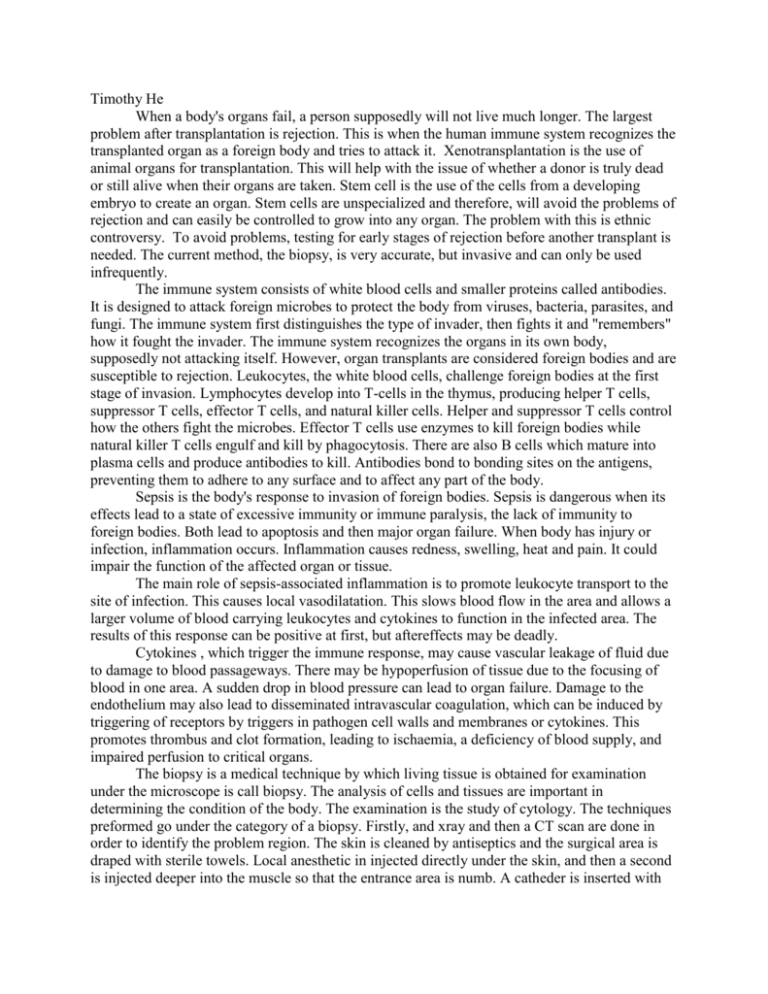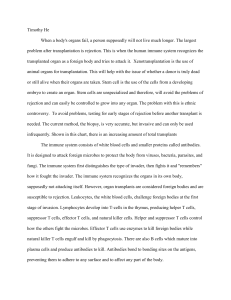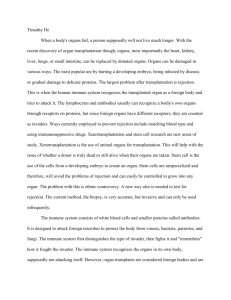Timothy He
advertisement

Timothy He When a body's organs fail, a person supposedly will not live much longer. The largest problem after transplantation is rejection. This is when the human immune system recognizes the transplanted organ as a foreign body and tries to attack it. Xenotransplantation is the use of animal organs for transplantation. This will help with the issue of whether a donor is truly dead or still alive when their organs are taken. Stem cell is the use of the cells from a developing embryo to create an organ. Stem cells are unspecialized and therefore, will avoid the problems of rejection and can easily be controlled to grow into any organ. The problem with this is ethnic controversy. To avoid problems, testing for early stages of rejection before another transplant is needed. The current method, the biopsy, is very accurate, but invasive and can only be used infrequently. The immune system consists of white blood cells and smaller proteins called antibodies. It is designed to attack foreign microbes to protect the body from viruses, bacteria, parasites, and fungi. The immune system first distinguishes the type of invader, then fights it and "remembers" how it fought the invader. The immune system recognizes the organs in its own body, supposedly not attacking itself. However, organ transplants are considered foreign bodies and are susceptible to rejection. Leukocytes, the white blood cells, challenge foreign bodies at the first stage of invasion. Lymphocytes develop into T-cells in the thymus, producing helper T cells, suppressor T cells, effector T cells, and natural killer cells. Helper and suppressor T cells control how the others fight the microbes. Effector T cells use enzymes to kill foreign bodies while natural killer T cells engulf and kill by phagocytosis. There are also B cells which mature into plasma cells and produce antibodies to kill. Antibodies bond to bonding sites on the antigens, preventing them to adhere to any surface and to affect any part of the body. Sepsis is the body's response to invasion of foreign bodies. Sepsis is dangerous when its effects lead to a state of excessive immunity or immune paralysis, the lack of immunity to foreign bodies. Both lead to apoptosis and then major organ failure. When body has injury or infection, inflammation occurs. Inflammation causes redness, swelling, heat and pain. It could impair the function of the affected organ or tissue. The main role of sepsis-associated inflammation is to promote leukocyte transport to the site of infection. This causes local vasodilatation. This slows blood flow in the area and allows a larger volume of blood carrying leukocytes and cytokines to function in the infected area. The results of this response can be positive at first, but aftereffects may be deadly. Cytokines , which trigger the immune response, may cause vascular leakage of fluid due to damage to blood passageways. There may be hypoperfusion of tissue due to the focusing of blood in one area. A sudden drop in blood pressure can lead to organ failure. Damage to the endothelium may also lead to disseminated intravascular coagulation, which can be induced by triggering of receptors by triggers in pathogen cell walls and membranes or cytokines. This promotes thrombus and clot formation, leading to ischaemia, a deficiency of blood supply, and impaired perfusion to critical organs. The biopsy is a medical technique by which living tissue is obtained for examination under the microscope is call biopsy. The analysis of cells and tissues are important in determining the condition of the body. The examination is the study of cytology. The techniques preformed go under the category of a biopsy. Firstly, and xray and then a CT scan are done in order to identify the problem region. The skin is cleaned by antiseptics and the surgical area is draped with sterile towels. Local anesthetic in injected directly under the skin, and then a second is injected deeper into the muscle so that the entrance area is numb. A catheder is inserted with either a clamp or needle at the end and is guided to the area of operation in the body. This is controlled using CT, ultrasound, and fluoroscopic guidance by radiologist and helpers. Cells are either sucked up by the needle or cut by the clamp (biotome). The tissue is placed on slides and sent to a pathologist. The operated area remains sore and black or blue for a short amount oftime where the tissue was damaged. There is a chance of excessive blood loss. The biopsy cannot be repeated for some time, is expensive, and invasive. Yet, it is currently the most accurate and efficient way for testing condition of organs. After cardiac transplantation, the goal of physicians is to prevent allograft rejection while minimizing immunosuppressive side effects. The current method of rejection surveillance is the endomycardial biopsy (EMB), which is invasive, expensive, subject to sampling error, interobserver variability (3-5) and has a morbidity rate of 0.5% to 1.5%. Deng et al. developed the AlloMap test based on recent studies that show that gene expression in peripheral blood mononuclear cells (PBMC) correlate to cardiac allograft rejection. 97 candidate genes in leukocytes were discovered to have some correlation with rejection. An additional 155 genes found to be related to the 97 genes were included in the gene set to test for rejection. Future research would include more extensive gene discovery using whole-genome-based array approaches, more specific analysis of pathways of specific genes during allograft rejection, and the role of AlloMap in other organ transplantations. The mitochondria are the powerhouse of the cell. They oxidize products of aytoplasmic metabolism to create the energy stored in adenosine triphosphate (ATP). Mitochondria also have the ability to synthesize their own proteins and lipids. They also have their own DNA (genetic material). The endosybiont hypothesis states that mitochondria may have evolved from bacteria into cells as a symbiotic relationship. Cells have provided mitochondria with a stable and safe environment and the mitochondria provide the cell with energy. If this is true, then studying the activity of the mitochondria can tell the activity of a cell by how much energy a mitochondrion produces. Model Organisms that can be used and are most easily kept include Drosophila melangaster and starfish. Fruit flies have an innate immune system while starfish have a more developed immune system with amoebocytes. Since fruit flies are more available, they will be focused on for this experiment. Fruit flies have a humoral response, in which fatty body cells send proteins to neutralize foreign bodies. In the haemocytic response, cells use phagocytosis to engulf foreign bodies. Drosophila also has toll-like receptors, which help “remember” the foreign body and how its own immune system fought against it. Erwinia carotovora was found by Basset et al. to be able to trigger an overall immune response in fruit flies. He tested for gene expression of leukocytes. Smart et al. noticed that in higher plants, mitochondrial function must be developing to meet the respiration need of ATP. Mutations are the causes of many advancements in the structure f biological systems. However, mitochondrial function and gene expression pathways are new research and have not been looked into excessively. During meiosis in sunflower anthers, mitochondrial gene expression was characterized. The sunflower (H. annuus) was used for this experiment. Six stages of meiosis were identified and investigated. By the pachtene stage, abnormalities were detected in the meiocyte walls. Expression fthe atpA Locus and eMS phenotype was concluded. Expression begins at the tetrad stage. In conclusion, the mitochondrial genes were expressed in higher levels first in the meiocyte cells ofthe anther, then later, the tapetal cells. This shows that mitochondrial activity may show an impact on general cellular activity. Expression was tested through situ hybridization. Proposed Experimental Design- Five groups of one hundred fruit flies will be used. One group will have unaltered fruit flies as the control. The other two groups will be infected with Erwinia carotovora, bacteria known to stimulate an immune response in Drosophila. One of the infected groups will have mitochondria tested for upgrade in activity regarding to cells related to the humoral response while the other group will have mitochondria from cells related to the immune response tested. Mitochondrial activity will be tested each day until the fly is able to heal from infection or dies from infection. The last pair of groups will also be infected. These two groups will have their mitochondria tested for gene expression in each response to foreign bodies. Mitochondria activity will be tested with the Mitochondrial Activity (Cytochrome C Oxidase Activity Assay) Assay Kit, cost: 236 Euros with 100 tests each. Mitochondria will be isolated with the mitochondria isolation kit for cultured cells, cost: $199.00 with 50 tests each. Erwinia carotovora used to infect Drosophila melangaster will cost $9.20 per culture. Gene expression will be tested using situ hybridization in an out of school lab.

![Immune Sys Quiz[1] - kyoussef-mci](http://s3.studylib.net/store/data/006621981_1-02033c62cab9330a6e1312a8f53a74c4-300x300.png)






